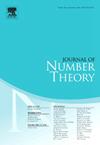Locally induced Galois representations with exceptional residual images
IF 0.6
3区 数学
Q3 MATHEMATICS
引用次数: 0
Abstract
In this paper, we classify all continuous Galois representations which are unramified outside and locally induced at p, under the assumption that is exceptional, that is, has image of order prime to p. We prove two results. If f is a level one cuspidal eigenform and one of the p-adic Galois representations associated to f has exceptional residual image, then is not locally induced and . If ρ is locally induced at p and with exceptional residual image, and furthermore certain subfields of the fixed field of the kernel of are assumed to have class numbers prime to p, then ρ has finite image up to a twist.
具有特殊残差图像的局部诱导伽罗瓦表示
本文在假设ρ的例外即对p有素数阶像的前提下,对在{p,∞}外无分支且在p处局部诱导的所有连续伽罗瓦表示ρ:Gal(Q - /Q)→GL2(Q - p)进行了分类,证明了两个结果。如果f是一个一级倒特征形,且与f相关的p进伽罗瓦表示中的一个ρf具有例外残差像,则ρf不是局部诱导的,且ap(f)≠0。如果ρ在p处局部诱导并且有例外残像,并且假设ρ的核的固定场的某些子域具有素数到p的类数,则ρ具有有限像直到扭转。
本文章由计算机程序翻译,如有差异,请以英文原文为准。
求助全文
约1分钟内获得全文
求助全文
来源期刊

Journal of Number Theory
数学-数学
CiteScore
1.30
自引率
14.30%
发文量
122
审稿时长
16 weeks
期刊介绍:
The Journal of Number Theory (JNT) features selected research articles that represent the broad spectrum of interest in contemporary number theory and allied areas. A valuable resource for mathematicians, the journal provides an international forum for the publication of original research in this field.
The Journal of Number Theory is encouraging submissions of quality, long articles where most or all of the technical details are included. The journal now considers and welcomes also papers in Computational Number Theory.
Starting in May 2019, JNT will have a new format with 3 sections:
JNT Prime targets (possibly very long with complete proofs) high impact papers. Articles published in this section will be granted 1 year promotional open access.
JNT General Section is for shorter papers. We particularly encourage submission from junior researchers. Every attempt will be made to expedite the review process for such submissions.
Computational JNT . This section aims to provide a forum to disseminate contributions which make significant use of computer calculations to derive novel number theoretic results. There will be an online repository where supplementary codes and data can be stored.
 求助内容:
求助内容: 应助结果提醒方式:
应助结果提醒方式:


